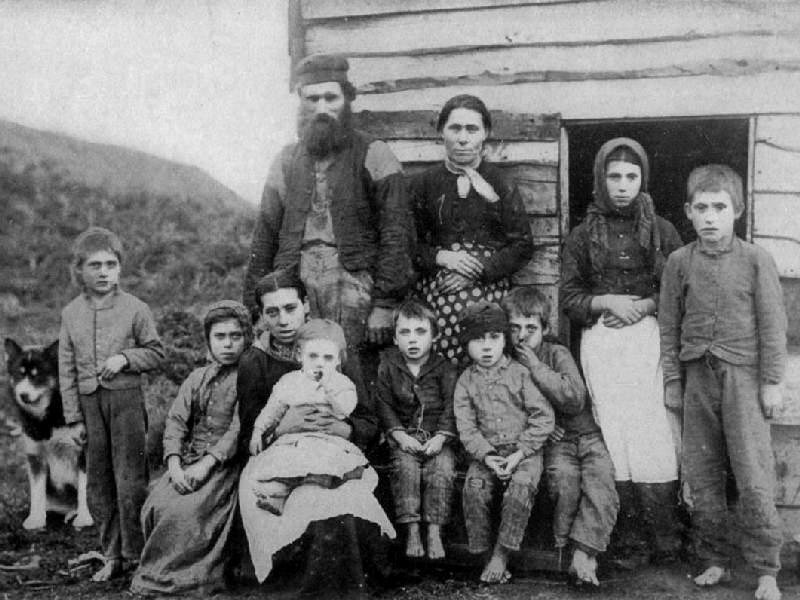
Canadian Regions: Newfoundland and Labrador

Figure 1.--In the early 20th century the small number of people that lived along the coast of Labrador all years round were called Liveyeres. Newfoundlanders only went to fish during the summer, but Liveyeres spent also the winter there. They were both of English and Native American origins. It seems that the name came from the southwest English dialect word "livier" meaning 'resident'. Here we see a Liveyeres family. A reader writes, "It is interesting to see a large family in a background that should be very hard during the wintertime. Surely the photo was taken during the temperate season (not very warm seeing at the clothing) and immediately the footwear was gone."
|
|
Newfoundland (Terra Nova) was discovered by the Italian John Cabot (Giovanni Caboto), working for English investors from from Bristol (1497). Sir Humphrey Gilbert claimed Newfoundland as England's first overseas colony under a Royal Charter of Queen Elizabeth I (1583). Historians date this as the foundation of the British Empire. Newfound Land was the first British colony outside the British Isles. England and France competed with each other during the 18th century for control of North America. The French moved down the St. Lawrence and the Great Lakes. The British claimed the area north and south. The northern region was Labrador and Newfoundland and the Hudson Bay area. Despite the northerly location, the climate of Newfoundland is moderated by the Gulfstream. Labrador has not only a rugged coast but a very cold climate, however, little affected by the Gulf Stream. The principal economic resource was the cod which could be fished on the Grand Banks. When the English emerged victorious in the French and Indian War (1763), Labrador and Newfoundland remained separate from Canada. Newfoundland and Labrador is the the youngest province in Canada. It was a separate British colony until 1949, It became self govetning (1855) and was awarded Dominion status (1907). Most of the population is located on Newfoundland which is an island separated from mainland Labrador by the Stait of Belle Island. Labrador borders on the Atlantic. Quebec juts east all along the Gulf of St. Lawrence. Labrador borders on Quebec, but because of lack of roads, Labrador was largely isolasted from Quebec. The small Labrador population was largely located along the coast and dependent on fishing. Newfoundland was devestated by World War I. Large numbers of men voluntered and casualties were devestating. The population was small to begin with and about a quater of the young men were lost in the War. Some believe that this was a major factor in eventual confederation with Canada. After World II confederation with Canada became an issue. The province voted by a narrow margin to join Canada (1948).
Sources
Wallace, Dillon. The Story of Grenfell of the Labrador: A Boy's Life of Wilfred T. Grenfell (1922).
HBC

Navigate the Historic Boys' Clothing Web Site:
[Return to the Main Canadian regional page]
[Return to the Main Canadian page]
[Introduction]
[Activities]
[Biographies]
[Chronology]
[Clothing styles]
[Countries]
[Bibliographies]
[Contributions]
[FAQs]
[Glossary]
[Images]
[Links]
[Registration]
[Tools]
[Boys' Clothing Home]
Navigate the Historic Boys' Clothing Web chronological pages:
[The 1930s]
[The 1940s]
[The 1950s]
[The 1960s]
[The 1970s]
[The 1980s]
[The 1990s]
Navigate the Historic Boys' Clothing Web Canadian pages:
[Art]
[Choir]
[Movies]
[School]
[Youth groups]

Created: 8:45 AM 9/25/2010
Last updated: 8:45 AM 9/25/2010


